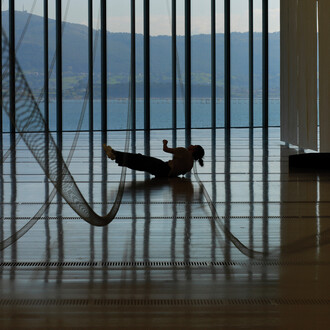Matter ceased to be a matter of content and became a matter of expression.
(Gilles Deleuze & Félix Guattari, A Thousand Plateaus, 1980)
In this exhibition, Lucía Gorostegui does not reiterate or reminisce: she constructs her own language from matter to interrogate the present. She does so through a set of previously unseen works which, while dialoguing with her previous research on perception, archives, and memory, unfold here as a new drift: a material, spatial, and sensitive drift whose epicenter is the place where it is produced—Mallorca—and the materials that accompany it—marés, glass, dust, silence.
The pieces brought together do not obey a narrative structure, but rather a logic of resonance. Instead of illustrating an idea, they beat in their own time. A time that is neither chronological nor linear, but rather what Deleuze broke down into three levels of temporal perception: the present of the present in the actuality of matter, the past of the present in the trace or memory contained in each form, and the present of the past in its possibility of being actualized again in each gaze. Within this framework, the works behave like living layers, traversed by temporalities that vibrate and intertwine.
In this work, matter is not a background or a support, but an agent. As Jane Bennett suggests with her concept of vibrant matter, stone, glass and sandstone are not passive elements, but actors with the capacity to affect, with histories inscribed in their form, with a life that exceeds the intention of those who manipulate them. In Gorostegui’s hands, they become porous receptors where gestures, contexts and intentions converge.
This material agency finds an echo in Karen Barad’s proposal, for whom observation is not an external act that interprets the world, but a constitutive part of the phenomenon itself. In other words, looking is not just seeing; it is affecting and being affected. The gaze is neither neutral nor external: it is situated, corporeal, political. Gorostegui, aware of this, composes her pieces not from a contemplative distance, but from a physical, almost tactile proximity. Her work does not demand only to be observed: it requires to be inhabited with all the senses.
Gorostegui’s research into the old school in Felanitx is a clear example of this. This school is linked in its past to the Pedagogical Missions and currently undergoing reconstruction, which appears here not as a mere document, but as a threshold, a place caught between ruin and potential. The school is not only what it was, but what it can still be. Its echo resounds in several of the works presented here: fragments of walls that are not exhibited as relics, but as living bodies that challenge us.
In this sense, the proposal is the antithesis of simulation as banal imitation. Although it draws on records, reproductions and reflections, what it constructs is not a copy but a reality in its difference: a liminal zone where the real, the virtual and the symbolic contaminate each other. Its images and structures do not seek to fix reality, but to activate new ways of understanding it from its edges, from its gaps, from that which tends to disappear.
As they move through the exhibition, viewers become co-creators of meaning. The gaze is no longer the place from which the image is dominated, but rather the terrain where time is sculpted into matter. In the works, there is no truth to be revealed, but rather a vibration to be heard, a fold to be folded, a difference to be embraced. Time is not that which guarantees repetition, but that which makes the new possible. This exhibition, as a whole, is an invitation to that new: not as a promise of the future, but as a power that is already happening, here and now, in stone, in glass, in the body.
(Text by Cristina Moreno García & Antoni Amaya Obrador)











